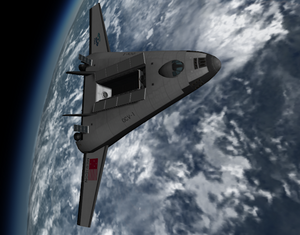Aries Orbital Carrier Vehicle: Difference between revisions
No edit summary |
|||
| Line 100: | Line 100: | ||
==Mission profile== | ==Mission profile== | ||
[[File:Aries 2.png|300px|thumb|'''Aries''' mated to its launch cradle and mounting at the edge of one of HRSC's runways. ]] | [[File:Aries 2.png|300px|thumb|'''Aries''' mated to its launch cradle and mounting at the edge of one of HRSC's runways. ]] | ||
Aries is a single-stage-to-orbit craft, which means that excluding propellant it does not detach or expend any part of the components onboard. Payload is integrated and the vehicle is inspected in a standard hangar complex, and the vehicle is wheeled out to a launching platform where it is mated and elevated into a vertical launching system. Thrust is provided by its three LARS-22 aerospikes burning a LOX/LH2 mix, providing a thrust/weight ratio of 1.54 at maximum payload capacity of | Aries is a single-stage-to-orbit craft, which means that excluding propellant it does not detach or expend any part of the components onboard. Payload is integrated and the vehicle is inspected in a standard hangar complex, and the vehicle is wheeled out to a launching platform where it is mated and elevated into a vertical launching system. Thrust is provided by its three LARS-22 aerospikes burning a LOX/LH2 mix, providing a thrust/weight ratio of 1.54 at maximum payload capacity of 37 tons. It follows a similar flight profile to a standard rocket launch, and is capable of conducting in-orbit rendezvouses. Once its mission is complete, Aries conducts a deorbit burn and is capable of landing at most large-sized runways- however most missions terminate at FSAA-manned facilities such as [[Helena Regent Space Center]], its principal area of operation. It glides to a landing and is slowed by parachute, where it can then be towed off the runway, inspected, and refitted for a follow-on flight with turn around times as little as one week. | ||
==Systems== | ==Systems== | ||
Latest revision as of 17:03, 5 March 2024
| Aries Orbital Carrier Vehicle | |
|---|---|
 Aries M1 Aries (OCV-1) in LEO during OM-14. | |
| Type | Reusable SSTO crew and cargo carrier |
| Owner | Federal Spatial Advancement Administration |
| Manufacturer | Laurein Aerospace |
| Specifications | |
| Dimensions | Height: 23.3 ft (7.1 m) Width (incl. wingspan): 125.9 ft (38.4m) |
| Dry mass | 278,109 lbs 126,148kg |
| Launch mass | 970,451 lbs (440,189 kg) (full fuel, no payload) |
| Rocket | 3x LARS linear aerospike, 4x OMS-137 Orbit Maneuvering System |
| Instruments | |
| |
| History | |
| First flight |
|
| Fate | Active service, 5 built |
The Aries Orbital Carrier Vehicle (OCV) is a class of Meridonian fully-reusable, Single-stage-to-orbit spaceplanes operated primarily by the Federal Spatial Advancement Administration, with a single model operated by the Meridon Air Forces for clandestine missions. Its program and official name, the Orbital Carrier Vehicle, is indicative of its purpose as a cargo carrier, however it is capable of extended-term stays in orbit as well as crew transfer.
Design and development for what would become the Aries began in the early 1980s as a proof of concept by independent researcher Levi Pelesa, and later his wife, Ashley. Both hired by Laurein Aerospace's Space Launch division in 1985 as engineers, Laurein pitched the concept to the FSAA in 1986 as a radical solution following the impending retirement of the Whiteflash series of launch vehicles for human spaceflight, proposing radically reduced costs per launch, higher flight availability, and the ability to operate using reduced infrastructural costs. The project was one of the most expensive government-funded projects in the history of Meridon, with development costs- particularly for the engine systems, which ran in excess of one trillion dollars over its lifespan in total and required the involvement of Marquesan assistance in development. Conducting atmospheric and ground test flights and operations throughout the mid to late 2010s, the first development shuttle, Aries, conducted a suborbital and then orbital flight in 2019.
Aries shuttles, alongside the Hercules cargo transports, form the backbone of Meridonian space exploration capability. Five have been built, with four in active service with the FSAA. A sixth was built as a mockup, static reference and for spare parts. The vehicle is capable of delivering a payload of up to 37 tons into low earth orbit.
Design and Development
Operational history
Mission profile
Aries is a single-stage-to-orbit craft, which means that excluding propellant it does not detach or expend any part of the components onboard. Payload is integrated and the vehicle is inspected in a standard hangar complex, and the vehicle is wheeled out to a launching platform where it is mated and elevated into a vertical launching system. Thrust is provided by its three LARS-22 aerospikes burning a LOX/LH2 mix, providing a thrust/weight ratio of 1.54 at maximum payload capacity of 37 tons. It follows a similar flight profile to a standard rocket launch, and is capable of conducting in-orbit rendezvouses. Once its mission is complete, Aries conducts a deorbit burn and is capable of landing at most large-sized runways- however most missions terminate at FSAA-manned facilities such as Helena Regent Space Center, its principal area of operation. It glides to a landing and is slowed by parachute, where it can then be towed off the runway, inspected, and refitted for a follow-on flight with turn around times as little as one week.
Systems
LARS engine
The Linear Aerospike Rocket System is a key component of the OCV propulsion system, providing highly-efficient, powerful, and thrust-vectored propulsion across all regimes of flight from sea level to vacuum.




